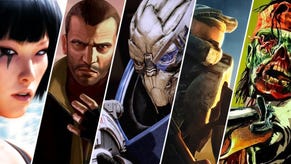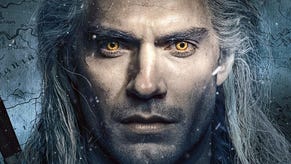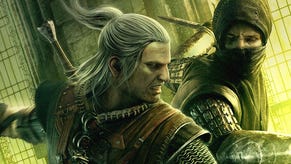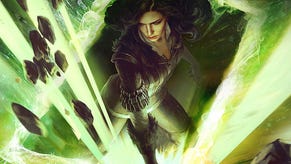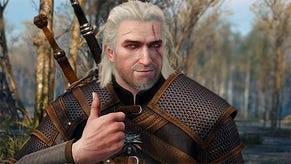Witcher 2: Gop shrugs off "dumbing down" accusations
Speaking in a Witcher 2 online fan demo, CDPR's Tomasz Gop drops news gameplay specifics, shows Geralt's final design and neatly dodges the console question. Full report by Stace Harman.
“First of all, the combat has absolutely not been dumbed down," Tomasz Gop, senior producer on The Witcher 2, is keen to assure those of us that have gathered for this online Q&A session.
“Nor has the game been consolised,” he continues.
That these words are juxtaposed with several seconds of frenetic mouse-clicking as Gop demos the combat in the Witcher 2 shouldn’t alarm too many people, as it later becomes evident that there is depth and flexibility in the combat system. However, it is clear that the subtle timing required by the first game’s combat system in order to build combos, is most definitely a thing of the past.
The ‘fast’ and ‘heavy’ combat styles from the first game are still present and, as before, each works better against a light or heavy-set foes. This time around the styles have been mapped to left and right mouse buttons respectively, allowing you to chain your attacks on the fly without having to switch between one move set and another.
There’s also more emphasis on the 'signs,' Geralt’s magical abilities that allow him to shoot fire from his finger tips or protect himself from attacks with a shield of electricity. It’s now possible to charge and aim these attacks, giving Geralt limited ranged combat options as well as being able to set traps for enemies. This is all reminiscent of, dare I mention it, Dragon Age.
Criticisms that the majority of the additional weapons in The Witcher were entirely superfluous have been addressed, and Gop is keen to highlight that you’ll have the option to invest some of Geralt’s levelling-up progress in increasing his combat prowess with these tools, giving you options outside of his silver and steel Witcher swords.
Overall, Gop’s promise that “the combat has been made more accessible," rather than dumbed down, seem to ring true.
The devil’s in the details
Gop goes on to discuss gameplay details, some reiterated and some new. There will be 16 ‘states’ in which the main plot, which Gop places at some 40 hours of gameplay, can end. Gop says that ten of these will feature big changes - such as the death of a companion or whether or not a particular country has been wiped from the map entirely - and the other six will be based on relatively minor details, such as which factions you’re on speaking terms with when the plot concludes.
The fashionable option of being able to import a save game from The Witcher is in effect here, but with no post-ending save available in the first game it’s unlikely that this will have major implications for the plot of the sequel.
Of course, there will be plenty going on outside of the main story arc, with numerous side quests, ‘romantic’ entanglements, and mini-games to entertain you. The fist fights and poker dice from The Witcher 1 make a return, though both have been tweaked, with QTE elements added to the former and physics to the latter, allowing you to manipulate the rolling of the dice. A new arm wrestling mini-game has been added and there’s now the chance to take control of characters aside from Geralt, with Gop confirming that Geralt’s bard companion, Dandelion, will be playable for parts of the game. At this stage, it’s not clear in what capacity you’ll play as him, or whether any of Geralt’s other companions, such as spellcaster Triss or the irascible Zoltan, will be available to play.
Man in the mirror
Gop was keen to address feedback he and his team have received about Geralt’s appearance in trailers for The Witcher 2. Fears that CD Projekt is looking to make Geralt younger or easier on the eye appear unfounded, and new concept art was released showing how Geralt will look in the final game. If anything, he’s has been made to look older, and the ‘poster boy’ looks of trailers released so far have been replaced by a more grizzled visage. The image shown wasn't meant for mass distribution, unfortunately, so we're not able to show it here.
CD Projekt has built a new game engine from scratch and the appearance of the game has benefitted greatly with some smart lighting effects, but the biggest improvement has been in the character models. These look more detailed, better animated than in the first game which, although pretty at times, suffered from some stilted animations, especially when the characters were engaged in conversation. The interface, too, has been overhauled, with abilities and magic now accessible from a radial menu that allows on-the-hoof selection and looks to further streamline combat.
What’s in the box?
Trevor Longino, head of PR and marketing of gog.com (Good Old Games, a sister company of CD Projekt) was on hand to outline the offer available through the digital distribution channel. Buying the game through gog.com will secure you the DRM-free digital download copy of the game – an exclusive to GOG - as well as a host of extras, including making of videos, the official soundtrack and a number of PDF downloadables in the form of an artbook, world map and papercraft models. Customers will also receive one free game from a selection of five on gog.com.
It hasn't yet been decided whether pre-loading of game content will be possible, nor was Longino able to specify the size of the download, though Gop confirmed that the physical version of the game will ship on two dual-layered DVDs. Despite this, Logino is keen to assure us that gog.com is more than capable of coping with the expected demand.
Gop was pleased to confirm full native 3D support as well as controller support, a sign that neither gameplay nor controls would hinder any potential console conversion.
Asked whether this release signalled a change of approach for the download service which, up until now, has focussed on the distribution of older titles, Logino hinted that The Witcher 1 may also be made available. It’s difficult to imagine that new titles from high-profile third-party publishers will be made available on GOG, however, with one of the bigger sticking points for many a publisher likely to be the site's ‘DRM-free’ mandate.
Technically speaking
Gop was vague when asked about potential plans to bring The Witcher 2 to consoles, stating simply that they would “like to see it happen”. Nor would he confirm what the team might work on beyond this game, stating that CD Projekt were very much a “one-game-at-a-time kind of team”. He did quash rumours that CD Projekt might next work on an MMO, however.
You’re not going to need too beefy a PC to play The Witcher 2. Recommended systems specs are yet to be released, but minimum specs are confirmed as: dual core 2GHz processor, 2GB RAM and a 512MB Geforce 8800. No Mac version is planned at this stage, nor will a demo be available prior to the game’s release. Gop was pleased to confirm full native 3D support as well as controller support, a sign that neither gameplay nor controls would hinder any potential console conversion.
Overall, the impression left by The Witcher 2 is very positive, with the key RPG elements from the first game remaining intact and combat being overhauled to give more direct control of the action. Hands-on time will reveal just how ‘consolised’ the game feels, but the signs are good that this will be a worthy successor to CD Projekt’s 2007 debut.
The Witcher 2 releases on PC on May 17.




